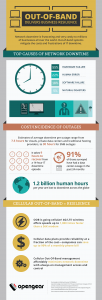Top Three Reasons To Adopt Cellular Out-Of-Band Management Solutions
3 Reasons for Cellular Out-Of-Band: Increased uptime, reduced expenses, faster & more cost effective.
Earlier this month, I was asked by Data Center Post about using cellular for out-of-band network management. My response identified the three biggest reasons why an IT department should consider using cellular connections instead of traditional modems for their OOB needs. I felt it was important enough to share with our faithful blog readers as well, so here is a brief recap (you can read the full article here):
“Ensuring up-time and system availability are key benchmarks for the IT department of just about every organization, and if it isn’t it probably should be. By adopting cellular out-of-band management solutions, organizations can expect to realize these three core benefits:
1) Avoid and mitigate the top causes of network downtime
From hardware or software failure to human error and natural disasters, there are a wide variety of issues can lead to downtime. By far, the most common problem network engineers face is hardware failure. Luckily, this issue in particular can be easily mitigated with out-of-band management tools.
2) Reduce expensive outages with more resilient systems
As this infographic illustrates, 1.2 billion work-hours are lost annually due to downtime because of how long an incident can last, how long it takes to recover from said incidents and how common downtime is today. Fortunately, all of these costs and wasted efforts can be easily mitigated with a simple investment in out-of-band management, as these tools help to reduce the length of outages and provide the oversight IT admins need to reduce their occurrence.
3) Faster and more cost-effective than legacy out-of-band connections
With the development and rise of cellular out-of-band management solutions, modems are no longer an ideal option in the vast majority of instances because they are slower, more expensive and less robust than cellular OOB connections. Not only is 4G LTE up to 1,000 times faster than a 56K modem, switching out a phone line for a data plan for OOB can help organizations reduce their monthly phone bills by up to 90 percent as well. Plus, cellular wireless networks ensure that IT admins can oversee infrastructure even when core connectivity is down.
As the costs related to downtime and to legacy out-of-band management rise, cellular OOB tools will increasingly become the best option available for companies in any industry. By being able to use cellular connections for oversight, organizations will have a far easier time guaranteeing uptime in all instances, all while reducing the stress placed on the IT department. At the end of the day, obtaining a cellular out-of-band management solution may be the best investment an organization makes.“
